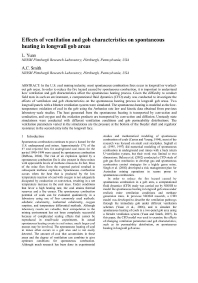 |
In the U.S. coal mining industry, most spontaneous combustion fires occur in longwall or worked-out gob areas. In order to reduce the fire hazard caused by spontaneous combustion, it is important to understand how ventilation and gob characteristics affect the spontaneous heating process. Given the difficulty to conduct field tests in such an environment, a computational fluid dynamics (CFD) study was conducted to investigate the effects of ventilation and gob characteristics on the spontaneous heating process in longwall gob areas. Two longwall panels with a bleeder ventilation system were simulated. The spontaneous heating is modeled as the low-temperature oxidation of coal in the gob using the Arrhenius rate law and kinetic data obtained from previous laboratory-scale studies. The heat generated from the spontaneous heating is transported by convection and conduction, and oxygen and the oxidation products are transported by convection and diffusion. Unsteady state simulations were conducted with different ventilation conditions and gob permeability distributions. The ventilation parameters varied in the simulations are the pressure at the bottom of the bleeder shaft and regulator resistance in the second entry inby the longwall face.
| Author(s): | Yuan-L, Smith-AC |
| Reference: | Proceedings of the 12th U.S./North American Mine Ventilation Symposium, Reno, Nevada, June 9-11, 2008. Wallace, Jr. KG. ed., Reno, NV: University of Nevada - Reno, 2008; :141-147 |
eovag (PDF, 200 KB)